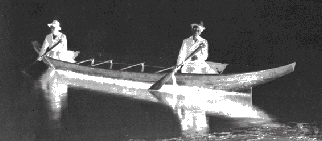An Inspection of Liquor in the 1860's
Who Drank and Why Did They?
PART TWO
The Native population that lived, in
and around, the bustling town of Victoria were a constant concern for the
white people who where there at the time. The Songhees were the closest to
the town and their presence was seen as somewhat of a threat to the morals
of the British community. With the boom in the population during the early
1860's many Indians moved closer to Victoria and became more of a fixture
in the town. Many people at the time believed that the Natives had only two
reasons for coming into Victoria. One reason was to obtain alcohol from
the numerous saloons. (21)
The other reason was believed to be to steal the peoples belongings.
Although there are some elements of truth to these assumptions, to simplify
the Natives presence in such a way is to misunderstand the nature of their
lives.

- photo courtesy of the BC Archives

- photo courtesy of the BC Archives
While it is true that some Natives had
become addicted to alcohol it must be noted that there were conditions that
led to their addiction. Since the earliest times of contact the relationship
between the Natives and the whites had been one which was based on exchange.
Both groups had something to gain out of the partnership.
(22)
However, the gold rush and settlement era that was ushered in through
the late 1850's and early 60's changed the face of the relationship on the
western coast. Gold was extracted from the land: not from the Indians. The
Natives were no longer seen as the necessary element that they once were.
As Robin Fisher says, "Rather than economic co-operation there was now economic
rivalry between the races." (23)
The Natives land was that which was needed and not the Indians themselves.
Once the white population began to take control of Native lands they removed
the most essential means of their survival.
From the beginning of the miners push into the land Natives resented there presence and consequent clashes ensued between the two groups:
As the Native population increased in the white sector of the colony many believed that all acts of debauchery were due to their presence. In fact, much of what went on was caused by the whites themselves. By disrupting the Native way of life, forcing them off their land and away from their resources, led to a situation of dependence. Alcohol became a symbol of the problem--- not the problem itself. Not all Natives drank and many were not involved in prostitution. Many simply tried to fit into a community structure that already existed. There was an increasing population of Natives at the time that made annual expeditions to Victoria and surrounding areas to join the labor force. (26) The mixing of cultures around commercial hubs such as Victoria led to the formation of an interesting community. One in which corrousing ran rampant and living conditions where not all that spectacular.
From the beginning of the miners push into the land Natives resented there presence and consequent clashes ensued between the two groups:
A large proportion of the mining population were transients, men who had cut lose from the ties and restraints of established societies. As a consequence of the unstable conditions that they lived under, many had become habituated to violence. (24)The gold rush forced many Natives into a becoming more reliant on the white colonists. Their resources had were diminished in large part because of the mining disturbances. (25) Many moved closer to Victoria to get closer to the commercial heart of the Island. It has been argued that it was that point, when the natives moved out of their traditional villages and congregated around mining towns, that many of their problems with liquor started.
As the Native population increased in the white sector of the colony many believed that all acts of debauchery were due to their presence. In fact, much of what went on was caused by the whites themselves. By disrupting the Native way of life, forcing them off their land and away from their resources, led to a situation of dependence. Alcohol became a symbol of the problem--- not the problem itself. Not all Natives drank and many were not involved in prostitution. Many simply tried to fit into a community structure that already existed. There was an increasing population of Natives at the time that made annual expeditions to Victoria and surrounding areas to join the labor force. (26) The mixing of cultures around commercial hubs such as Victoria led to the formation of an interesting community. One in which corrousing ran rampant and living conditions where not all that spectacular.